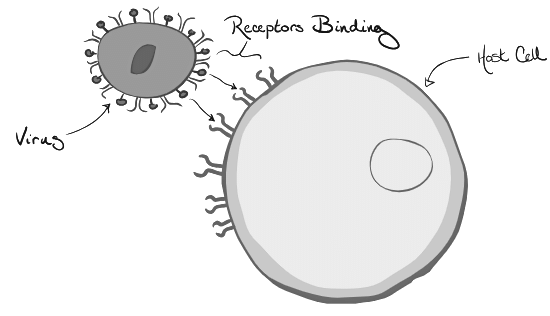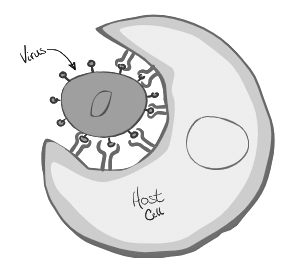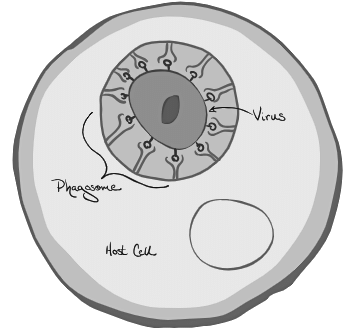Phagocytosis - Cellular Process | Biology for MCAT PDF Download
| Table of contents |

|
| Introduction |

|
| What is phagocytosis? |

|
| How does phagocytosis happen? |

|
| Phagocytosis and the immune system |

|
Introduction
Have you ever been curious about how viruses or other infectious agents invade cells to initiate an infection? In order to fulfill various cellular functions, many cells need to transport a diverse range of materials across their plasma membrane and into their cytoplasm. While smaller molecules and chemicals can be pulled across the plasma membrane and into the cytoplasm through methods like ion pumps, voltage-gated channels, or osmosis, larger objects such as viruses, bacteria, or other particles are too large to pass through small channels. Instead, cells employ a process called endocytosis, wherein they engulf these larger objects and draw them into their cytoplasm. Endocytosis encompasses various types, with one particular type being phagocytosis.
What is phagocytosis?
Phagocytosis is a cellular process characterized by the binding of a cell to a target on its surface and the subsequent engulfment of the target as the cell draws it inward. It is commonly observed when cells aim to eliminate entities such as viruses or infected cells and is frequently employed by immune system cells.
Phagocytosis stands apart from other forms of endocytosis due to its specificity, relying on the cell's ability to bind to the desired target using cell surface receptors. The occurrence of phagocytosis necessitates physical contact between the cell and the particle it intends to engulf.
The selection of cell surface receptors for phagocytosis depends on the type of cell performing the process. The following are the most prevalent receptor types:
- Opsonin receptors: These receptors recognize and bind to bacteria or particles that have been coated with immunoglobulin G (IgG) antibodies by the immune system. Coating potential threats with antibodies signals other cells to destroy them. The immune system may also employ the complement system, a group of proteins that tags bacteria, as another means to eliminate pathogens and protect the host.
- Scavenger receptors: Scavenger receptors bind to molecules produced by bacteria. Most bacteria and other foreign cellular species generate an extracellular matrix of proteins. This matrix serves as a distinctive identifier for the immune system, as human cells do not produce the same protein matrix.
- Toll-like receptors: Toll-like receptors are named after a similar receptor found in fruit flies, encoded by the Toll gene. They bind to specific molecules produced by bacteria. Toll-like receptors play a crucial role in the innate immune system, as they recognize and identify bacterial pathogens, triggering an immune response. The body produces various types of Toll-like receptors, each with its binding specificity for different molecules.
- Antibodies: Certain immune cells generate antibodies that can bind to specific antigens. This process resembles how Toll-like receptors recognize and identify the type of bacteria infecting the host. Antigens act as molecular markers, aiding the immune system in identifying the specific threat it needs to combat.
How does phagocytosis happen?
In order to understand the process of phagocytosis more clearly, let's follow the example of a macrophage, a type of immune cell, engulfing a virus. It's important to note that various types of cells can perform phagocytosis.- Contact between the virus and the cell needs to occur.
- The immune cell may accidentally encounter a virus in the bloodstream, or it can move through chemotaxis. Chemotaxis refers to the movement of an organism or cell in response to a chemical stimulus. Many immune system cells respond to cytokines, which are small proteins specifically used for cell signaling. Cytokines guide cells to particular areas in the body where the virus or particle is present. This is commonly observed in localized infections, such as a bacterial infection in a skin wound.
- The virus binds to the cell surface receptors on the macrophage.
- Different cell types express various receptors. Some receptors are general, distinguishing self-produced molecules from potential threats, while others are highly specific, such as toll-like receptors or antibodies. Successful binding of the cell surface receptors is necessary for the macrophage to initiate phagocytosis.
- Viruses may possess surface receptors that specifically interact with those on the macrophage.
- Viruses require access to the host cell's cytoplasm or nucleus to replicate and cause infection. They use their surface receptors to interact with immune system cells and exploit the immune response to gain entry into the cell. In some cases, when a virus interacts with a host cell, the cell can successfully destroy the virus, halting the spread of infection. However, there are instances where the host cell engulfs the virus, and the virus deceives the cell, gaining access to the necessary resources for replication. Once this occurs, other immune system cells identify and eliminate the infected cell to prevent further viral replication and infection.

- Viruses require access to the host cell's cytoplasm or nucleus to replicate and cause infection. They use their surface receptors to interact with immune system cells and exploit the immune response to gain entry into the cell. In some cases, when a virus interacts with a host cell, the cell can successfully destroy the virus, halting the spread of infection. However, there are instances where the host cell engulfs the virus, and the virus deceives the cell, gaining access to the necessary resources for replication. Once this occurs, other immune system cells identify and eliminate the infected cell to prevent further viral replication and infection.
- The macrophage initiates the process of engulfing the virus by surrounding it and pulling it into the cell.
- Rather than transporting the large particle across the plasma membrane, which could potentially cause permanent damage to the membrane, phagocytosis employs extensions of the cytoplasm called pseudopods. These pseudopods extend outward on both sides of the virus, gradually meeting and enclosing the virus within a membrane. It's important to note that cells possess a reasonable level of flexibility and fluidity.
- In the case of our virus example, the macrophage and the virus are initially bound at the cell surface. The cell proceeds to draw the virus inward, forming a pocket-like indentation without causing harm to the plasma membrane. It is worth remembering that cells exhibit a considerable degree of flexibility and fluidity.

- The virus that has been surrounded by the macrophage is enclosed within a membrane-bound structure called a "phagosome" in the cytoplasm.
- The pseudopods extend and converge, bringing the edges of the pocket together to create a phagosome. The phagosome is formed as the plasma membrane wraps around the virus, effectively encapsulating it within the cell.

- The pseudopods extend and converge, bringing the edges of the pocket together to create a phagosome. The phagosome is formed as the plasma membrane wraps around the virus, effectively encapsulating it within the cell.
- The phagosome and lysosome merge together, forming a structure known as a "phagolysosome".
- Lysosomes are similar bubble-like structures to phagosomes that carry out waste processing within the cell. The term "lysis" refers to the breakdown of substances, which helps to understand the function of a lysosome. Without the fusion with a lysosome, the phagosome would not be able to effectively handle its contents.
- The phagolysosome regulates the pH to degrade its contents.
- By significantly reducing the pH of its internal environment, a lysosome or phagolysosome can break down the substances within itself. The acidic environment created inside the phagolysosome is instrumental in destroying or neutralizing the materials within it, preventing them from infecting the cell.
- Certain viruses exploit the acidic pH to escape from the phagolysosome and initiate replication within the cytoplasm. For instance, the influenza virus utilizes the pH drop to trigger a structural change, enabling its release into the cytoplasm.
Once the substances have been neutralized, the phagolysosome transforms into a residual body that contains the waste products. Eventually, the residual body is expelled from the cell.
Phagocytosis and the immune system
Phagocytosis plays a vital role in the immune system, performed by various immune cells such as neutrophils, macrophages, dendritic cells, and B lymphocytes. Through phagocytosis, immune cells can identify and target specific pathogenic or foreign particles, providing valuable information about the threats circulating in the body.
One of the primary functions of phagocytosis in the immune system is to ingest and eliminate pathogens, including viruses, bacteria, and infected cells. By destroying the infected cells, the immune system effectively restricts the spread and multiplication of the infection. As previously mentioned, the acidic environment within the phagolysosome contributes to the destruction or neutralization of the engulfed contents. Additionally, immune cells utilize other mechanisms to eliminate pathogens within the phagolysosome, such as:
- Oxygen Radicals: These highly reactive molecules react with proteins, lipids, and other biological molecules, causing oxidative stress and potentially destroying cell structures.
- Nitric Oxide: Similar to oxygen radicals, nitric oxide is a reactive substance that interacts with superoxide to generate additional molecules that damage various biological molecules.
- Antimicrobial Proteins: These proteins specifically target and kill bacteria. Examples include proteases, which destroy essential proteins in bacteria, and lysozyme, which attacks the cell walls of gram-positive bacteria.
- Antimicrobial Peptides: Similar to antimicrobial proteins, antimicrobial peptides have the ability to attack and eliminate bacteria. Defensins, for instance, target bacterial cell membranes.
- Binding Proteins: Binding proteins play a significant role in the innate immune system by competitively binding to proteins or ions that bacteria or viruses rely on for replication. For instance, lactoferrin found in mucosal membranes binds to iron ions, which are essential for bacterial growth.
These mechanisms work in concert to ensure effective elimination of pathogens and bolster the immune response.
|
233 videos|16 docs|32 tests
|














